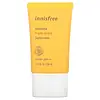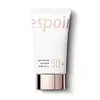What's inside
What's inside
 Key Ingredients
Key Ingredients

 Benefits
Benefits

 Concerns
Concerns

 Ingredients Side-by-side
Ingredients Side-by-side

Water
Skin ConditioningPropylheptyl Caprylate
EmollientTitanium Dioxide
Cosmetic ColorantZinc Oxide
Cosmetic ColorantCyclohexasiloxane
EmollientButylene Glycol Dicaprylate/Dicaprate
EmollientDisiloxane
Skin ConditioningButylene Glycol
HumectantPolyglyceryl-5 Polyricinoleate
EmulsifyingPolymethylsilsesquioxane
Glycerin
HumectantCaprylyl Methicone
Skin ConditioningDicaprylyl Ether
EmollientNiacinamide
SmoothingDisteardimonium Hectorite
StabilisingPolyglyceryl-3 Polydimethylsiloxyethyl Dimethicone
Skin ConditioningCalcium Aluminum Borosilicate
Magnesium Sulfate
1,2-Hexanediol
Skin ConditioningTriethoxycaprylylsilane
Octyldodecanol
EmollientParfum
MaskingDicaprylyl Carbonate
EmollientCI 77492
Cosmetic ColorantCaprylyl Glycol
EmollientGlyceryl Caprylate
EmollientMica
Cosmetic ColorantEthylhexylglycerin
Skin ConditioningAluminum Hydroxide
EmollientAdenosine
Skin ConditioningCI 77491
Cosmetic ColorantEchium Plantagineum Seed Oil
Skin ConditioningBoron Nitride
AbsorbentSodium Hyaluronate
HumectantPropylene Glycol Dicaprylate/Dicaprate
EmollientSaccharide Isomerate
HumectantPropanediol
SolventCI 77499
Cosmetic ColorantTocopherol
AntioxidantHelianthus Annuus Seed Oil Unsaponifiables
EmollientCardiospermum Halicacabum Flower/Leaf/Vine Extract
Skin ConditioningDimethicone/Vinyl Dimethicone Crosspolymer
Skin ConditioningOryza Sativa Bran Oil
EmollientLespedeza Capitata Leaf/Stem Extract
Skin ConditioningSodium Citrate
BufferingCitric Acid
BufferingWater, Propylheptyl Caprylate, Titanium Dioxide, Zinc Oxide, Cyclohexasiloxane, Butylene Glycol Dicaprylate/Dicaprate, Disiloxane, Butylene Glycol, Polyglyceryl-5 Polyricinoleate, Polymethylsilsesquioxane, Glycerin, Caprylyl Methicone, Dicaprylyl Ether, Niacinamide, Disteardimonium Hectorite, Polyglyceryl-3 Polydimethylsiloxyethyl Dimethicone, Calcium Aluminum Borosilicate, Magnesium Sulfate, 1,2-Hexanediol, Triethoxycaprylylsilane, Octyldodecanol, Parfum, Dicaprylyl Carbonate, CI 77492, Caprylyl Glycol, Glyceryl Caprylate, Mica, Ethylhexylglycerin, Aluminum Hydroxide, Adenosine, CI 77491, Echium Plantagineum Seed Oil, Boron Nitride, Sodium Hyaluronate, Propylene Glycol Dicaprylate/Dicaprate, Saccharide Isomerate, Propanediol, CI 77499, Tocopherol, Helianthus Annuus Seed Oil Unsaponifiables, Cardiospermum Halicacabum Flower/Leaf/Vine Extract, Dimethicone/Vinyl Dimethicone Crosspolymer, Oryza Sativa Bran Oil, Lespedeza Capitata Leaf/Stem Extract, Sodium Citrate, Citric Acid
Water
Skin ConditioningButylene Glycol
HumectantC12-15 Alkyl Benzoate
AntimicrobialEthylhexyl Methoxycinnamate
UV AbsorberTitanium Dioxide
Cosmetic ColorantDiethylamino Hydroxybenzoyl Hexyl Benzoate
UV FilterBis-Ethylhexyloxyphenol Methoxyphenyl Triazine
Skin ConditioningCyclopentasiloxane
EmollientSilica
AbrasiveCyclohexasiloxane
EmollientTocopheryl Acetate
AntioxidantAlthaea Officinalis Root Extract
Skin ConditioningLavandula Angustifolia Extract
Skin ConditioningAnthemis Nobilis Flower Extract
MaskingCentella Asiatica Extract
CleansingLippia Citriodora Leaf Extract
AstringentAloe Barbadensis Leaf Extract
EmollientMagnesium Aspartate
Skin ConditioningZinc Gluconate
Skin ConditioningCalcium Gluconate
HumectantCopper Gluconate
Skin ConditioningPhenyl Trimethicone
Skin ConditioningAluminum Stearate
Cosmetic ColorantPolyacrylate-13
Polyhydroxystearic Acid
EmulsifyingAlumina
AbrasivePolyisobutene
Stearic Acid
CleansingGlyceryl Caprylate
EmollientCarbomer
Emulsion StabilisingEthylhexylglycerin
Skin ConditioningPolysorbate 20
EmulsifyingDisodium EDTA
Phenoxyethanol
PreservativeCI 77491
Cosmetic ColorantCI 77492
Cosmetic ColorantParfum
MaskingWater, Butylene Glycol, C12-15 Alkyl Benzoate, Ethylhexyl Methoxycinnamate, Titanium Dioxide, Diethylamino Hydroxybenzoyl Hexyl Benzoate, Bis-Ethylhexyloxyphenol Methoxyphenyl Triazine, Cyclopentasiloxane, Silica, Cyclohexasiloxane, Tocopheryl Acetate, Althaea Officinalis Root Extract, Lavandula Angustifolia Extract, Anthemis Nobilis Flower Extract, Centella Asiatica Extract, Lippia Citriodora Leaf Extract, Aloe Barbadensis Leaf Extract, Magnesium Aspartate, Zinc Gluconate, Calcium Gluconate, Copper Gluconate, Phenyl Trimethicone, Aluminum Stearate, Polyacrylate-13, Polyhydroxystearic Acid, Alumina, Polyisobutene, Stearic Acid, Glyceryl Caprylate, Carbomer, Ethylhexylglycerin, Polysorbate 20, Disodium EDTA, Phenoxyethanol, CI 77491, CI 77492, Parfum
 Reviews
Reviews

Ingredients Explained
These ingredients are found in both products.
Ingredients higher up in an ingredient list are typically present in a larger amount.
Butylene Glycol (or BG) is used within cosmetic products for a few different reasons:
Overall, Butylene Glycol is a safe and well-rounded ingredient that works well with other ingredients.
Though this ingredient works well with most skin types, some people with sensitive skin may experience a reaction such as allergic rashes, closed comedones, or itchiness.
Learn more about Butylene GlycolCi 77491 is also hydrated iron III oxide. It's sole purpose is to give a red/pink hue to products.
Iron III oxides are classified as inorganic chemicals for coloring.
Synthetically created Ci 77491 is considered safer than those naturally found. This is because the synthetically created version may contain less impurities. Iron oxides are generally non-toxic and non-allergenic.
Learn more about CI 77491Ci 77492 is also hydrated iron III oxide. It's sole purpose is to give a yellow hue to products.
Iron III oxides are classified as inorganic chemicals for coloring.
Synthetically created Ci 77492 is considered safer than those naturally found. This is because the synthetically created version may contain less impurities. Iron oxides are generally non-toxic and non-allergenic.
Learn more about CI 77492Cyclohexasiloxane is a type of silicone more commonly known as D6. It is an emollient and solvent.
Cyclohexasiloxane is used to evenly distribute ingredients throughout the product. When applied to the skin, Cyclohexasiloxane evaporates and leaves behind a silky feel.
As an emollient, it can help the skin feel soft and hydrated. It is also used to reduce frizz in hair products.
Learn more about CyclohexasiloxaneEthylhexylglycerin (we can't pronounce this either) is commonly used as a preservative and skin softener. It is derived from glyceryl.
You might see Ethylhexylglycerin often paired with other preservatives such as phenoxyethanol. Ethylhexylglycerin has been found to increase the effectiveness of these other preservatives.
Glyceryl Caprylate comes from glycerin and caprylic acid, a fatty acid from coconut. It has emollient and emulsifier properties.
As an emollient, it helps hydrate your skin. Emollients work by creating a barrier on your skin to trap moisture in, helping to keep your skin soft and smooth.
On the other hand, emulsifiers prevent ingredients (such as oil and water) from separating.
Learn more about Glyceryl CaprylateParfum is a catch-all term for an ingredient or more that is used to give a scent to products.
Also called "fragrance", this ingredient can be a blend of hundreds of chemicals or plant oils. This means every product with "fragrance" or "parfum" in the ingredients list is a different mixture.
For instance, Habanolide is a proprietary trade name for a specific aroma chemical. When used as a fragrance ingredient in cosmetics, most aroma chemicals fall under the broad labeling category of “FRAGRANCE” or “PARFUM” according to EU and US regulations.
The term 'parfum' or 'fragrance' is not regulated in many countries. In many cases, it is up to the brand to define this term.
For instance, many brands choose to label themselves as "fragrance-free" because they are not using synthetic fragrances. However, their products may still contain ingredients such as essential oils that are considered a fragrance by INCI standards.
One example is Calendula flower extract. Calendula is an essential oil that still imparts a scent or 'fragrance'.
Depending on the blend, the ingredients in the mixture can cause allergies and sensitivities on the skin. Some ingredients that are known EU allergens include linalool and citronellol.
Parfum can also be used to mask or cover an unpleasant scent.
The bottom line is: not all fragrances/parfum/ingredients are created equally. If you are worried about fragrances, we recommend taking a closer look at an ingredient. And of course, we always recommend speaking with a professional.
Learn more about ParfumTitanium dioxide is a mineral UV filter widely used in sunscreens and cosmetics.
It is one of only two UV filters officially classified as “mineral” by regulatory agencies, the other being zinc oxide.
Titanium dioxide provides broad-spectrum protection mostly in the UVB and UVAII range, with some protection in the UVAI range.
While its UVA protection isn’t as strong as zinc oxide’s, the difference is minor.
A common myth is that mineral UV filters reflect UV light. However, modern research shows titanium dioxide absorbs UV radiation like chemical filters (~95% absorption & 5% reflection).
Thanks to its non-irritating nature, titanium dioxide is suitable for sensitive, acne-prone, or redness-prone skin. It is unlikely to cause "eye sting" like other sunscreen ingredients.
A major drawback of this ingredient is its white cast and thick texture. This is why mineral sunscreens often leave a white cast and are less cosmetically elegant than chemical/hybrid sunscreens.
To improve white cast and spreadability, micronized or nano-sized titanium dioxide is often used.
There are ongoing concerns surrounding nano-titanium oxide's impact on marine ecosystems.
There is no conclusive evidence that any form of titanium oxide (or any other sunscreen ingredients) will cause harm to marine ecosystems or coral reefs. The science is still developing but many consumers are keeping a close eye on this issue.
Please note, many destinations have reef-safety sunscreen rules. For instance, the U.S. Virgin Islands advises all visitors to use non-nano mineral sunscreens.
Nano mineral sunscreens once raised safety concerns about absorption into skin.
Extensive research has shown that they do not penetrate healthy or damaged skin; they remain safely on the surface and the top layer of dead skin (stratum corneum).
You'll likely find titanium dioxide bundled with alumina, silica, or dimethicone. These ingredients help make titanium dioxide highly photostable; this prevents it from interacting with other formula components under UV light.
Learn more about Titanium DioxideWater. It's the most common cosmetic ingredient of all. You'll usually see it at the top of ingredient lists, meaning that it makes up the largest part of the product.
So why is it so popular? Water most often acts as a solvent - this means that it helps dissolve other ingredients into the formulation.
You'll also recognize water as that liquid we all need to stay alive. If you see this, drink a glass of water. Stay hydrated!
Learn more about Water